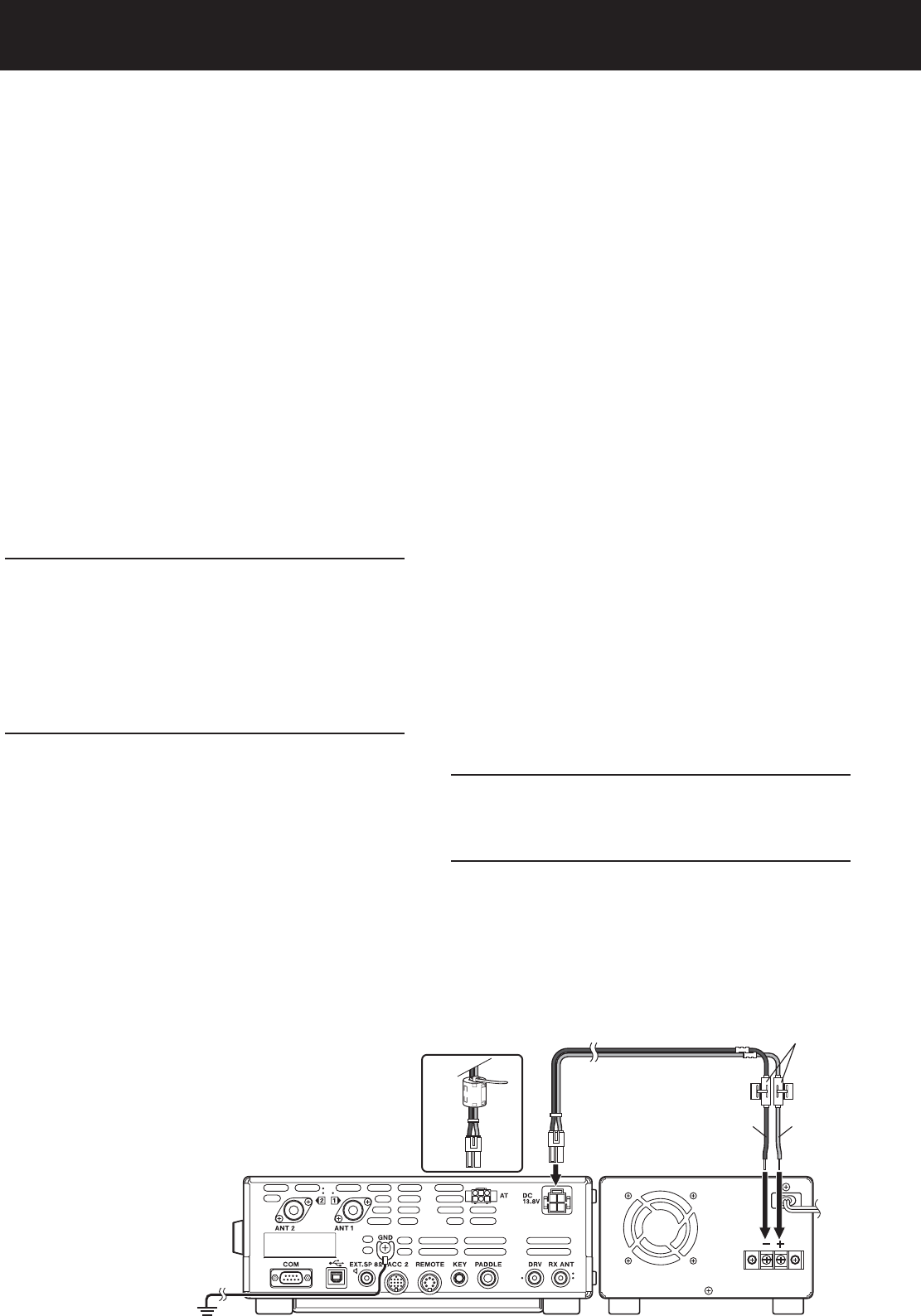
1
,167$//$7,21
TS-590S
Fuse (25 A)
Red (+)
Black (
ï
)
DC Power supply
(20.5 A or more)
E-type only
$17(11$&211(&7,21
An antenna system consists of an antenna, feed
line, and ground. The transceiver can give excellent
results if the antenna system and its installation are
JLYHQFDUHIXODWWHQWLRQ8VHDSURSHUO\DGMXVWHG
DQWHQQDRIJRRGTXDOLW\DKLJKTXDOLW\FRD[LDO
cable, and top-quality connectors. All connections
must be clean and tight.
After making the connections, match the impedance
of the coaxial cable and antenna so that the SWR is
1.5:1 or less. High SWR will cause the transmit output
to drop and may lead to radio frequency interference
with consumer products such as stereo receivers
and televisions. You may even cause interference
with your own transceiver. Reports that your signal is
distorted could indicate that your antenna system is
not efficiently radiating your transceiver’s power.
Connect your primary HF/ 50 MHz antenna feed
line to ANT 1 on the rear of the transceiver. If you
are using two HF/ 50 MHz antennas, connect the
secondary antenna to ANT 2. Refer to page 9 for the
location of the antenna connectors.
The LF band is outputed only from the DRV terminal.
Note:
X Transmitting without connecting an antenna or other
matched load may damage the transceiver. Always connect
the antenna to the transceiver before transmitting.
X All fixed stations should be equipped with a lightning arrester
to reduce the risk of fire, electric shock, and transceiver
damage.
X The transceiver’s protection circuit will activate when
the SWR is greater than 1.5:1; however, do not rely on
protection to compensate for a poorly functioning antenna
system.
*5281'&211(&7,21
At a minimum, a good DC ground is required to
prevent such dangers as electric shock. For superior
communications, a good RF ground is required
against which the antenna system can operate. Both
of these conditions can be met by providing a good
earth ground for your station. Bury one or more
ground rods or a large copper plate under the ground,
then connect this to the transceiver GND terminal.
Use heavy gauge wire or a copper strap, cut as short
as possible, for this connection. Do not use a gas
pipe, an electrical conduit, or a plastic water pipe as a
ground.
/,*+71,1*3527(&7,21
Even in areas where lightning storms are less
common, there is always a chance that a storm will
occur each year. Consider carefully how to protect
your equipment and home from lightning. The
installation of a lightning arrestor is a start, but there
is more that you can do. For example, terminate
your antenna system transmission lines at an entry
panel that you install outside your home. Ground this
entry panel to a good outside ground, then connect
the appropriate feed lines between the entry panel
and your transceiver. When a lightning storm occurs,
disconnecting the feed lines from your transceiver will
ensure additional protection.
'&32:(56833/<&211(&7,21
In order to use this transceiver, you need a separate
13.8 V DC power supply that must be purchased
separately. Do not directly connect the transceiver
to an AC outlet. Use the supplied DC power cable to
connect the transceiver to a regulated power supply.
Do not substitute a cable with smaller gauge wires.
The current capacity of the power supply must be
20.5 A peak or more.
First, connect the DC power cable to the regulated DC
power supply; the red lead to the positive terminal and
the black lead to the negative terminal. Next, connect
the DC power cable to the transceiver’s DC power
connector.
• Press the connectors firmly until the locking tab
clicks.
• Attach the line filter to the DC cable as shown
below (E-type only).
Note:
X Before connecting the DC power supply to the transceiver,
be sure to switch OFF the DC power supply and transceiver.
X Do not plug the DC power supply into an AC outlet until you
make all connections.


















